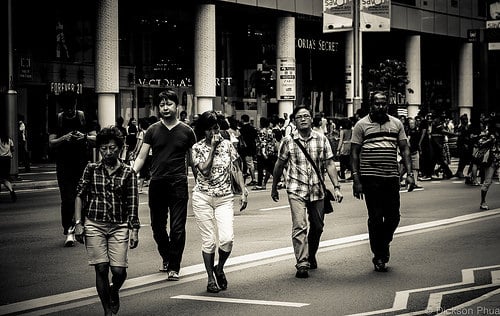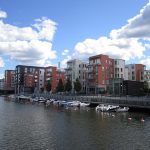Study links walkability with higher property values, longer lives, lower crime
Better health is just the beginning of walking’s benefits. Walking can also improve neighborhoods, raise housing values and even reduce crime. A recent study, “Does walkability matter? An examination of walkability’s impact on housing values, foreclosures and crime,” from John I. Gilderbloom, William W. Riggs and Wesley L. Meares, examined the link between sustainability and walkability in a medium-sized city.

A study shows a positive correlation between neighborhoods’ walkability and their citizens’ health, stability, and social engagement. Image from Dickson Phua.
The researchers identified 170 neighborhoods in one medium-sized city — Louisville, Kentucky — with the goal of figuring out whether walkability impacts neighborhood sustainability. As the researchers note, until 2008 there wasn’t a “reliable measure of the social, health, and economic impact of walkable neighborhoods” available. But the field changed with the introduction of “Walkscore™, which measures how accessible daily living activities are by foot.”
Specifically, the researchers looked at how an area’s Walkscore relates to these measures of urban sustainability: neighborhood housing valuation; foreclosures; and crime. Their findings may be surprising to some: Not only does walkability help walkers (by increasing their lifespan), but it can also impact whole communities and neighborhoods for the better.
The researchers sum up walkability in their own words: “We use the term ‘walkability’ as a way to measure the lives of ‘foot people,’ evaluating the questions of whether walkability impacts crime, foreclosures and housing values in neighborhoods… the development of walkability measurement tools has enabled planners and academics to measure the social and economic impacts of walkability on a more empirical level—comparing places where daily living activities can be accomplished by foot and one might not need a car to other areas that require inhabitants to be more car-dependent.”
For the study, researchers chose Louisville for a number of reasons: its 741,000-person population is spread out over 385 square miles, with a relatively reliable housing market and neighborhood dynamics that are “representative” of other smaller metro areas. It’s “a good place to study growth dynamics because it has a population over 50,000 persons and not located within 20 miles of a large city,” wrote the researchers. Plus, it has different neighborhood types, with some more and some less walkable.
“Our research question was simple: Does walkability matter? Our results indicate that in regard to neighborhood stability, economic resilience and livability, the aspects that make up a walkable community have value,” they report. While initial results showed no relation between, for example, walkability and crime, when the researchers dug in deeper and analyzed neighborhoods with a 50 percent or higher minority population, they found that walking was in fact associated with reduced crime. In terms of residents’ health, they discovered that those living in less walkable areas were more likely to have shorter lives; as for housing prices, they learned that as people move towards walking-friendly areas, housing costs rise. (Read the study and learn about its methodology here.)
More compelling than the study’s findings are its implications. Three policy areas in particular are proposed: land use, street design and affordability, each with the goal of increasing the accessibility, the safety and the appeal of walking. “Demand is shifting from unwalkable suburbs,” explain the researchers. People are moving — nay, walking — to neighborhoods that are safe, walkable, gentrified and close to school and work, or, in a word, neighborhoods that are “sustainable.”
Related Posts
Category: Infrastructure

















